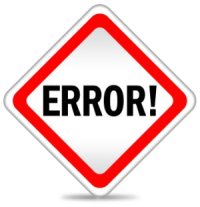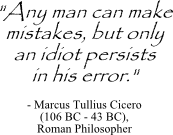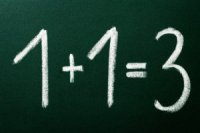Learn from mistakes by keeping track of your most important decisions
 We all make mistakes, but mistakes are not accidents. A mistake is not something that happens as a random event. By definition, a mistake is an action, judgment or decision that creates an undesired or unintended outcome. Causes for mistakes include carelessness, insufficient knowledge, poor analysis or reasoning, confusion, and misplaced confidence. From these causes it is clear that learning from mistakes is possible, and in many cases mistakes can be traced back to errors in decision making.
We all make mistakes, but mistakes are not accidents. A mistake is not something that happens as a random event. By definition, a mistake is an action, judgment or decision that creates an undesired or unintended outcome. Causes for mistakes include carelessness, insufficient knowledge, poor analysis or reasoning, confusion, and misplaced confidence. From these causes it is clear that learning from mistakes is possible, and in many cases mistakes can be traced back to errors in decision making.
The Connected Decisions™ framework is about creating knowledge. This knowledge comes from decisions that successfully generate desired results, as well as learning from mistakes that come from unintended consequences. Sometimes this learning comes from examining our own decision errors. However, when decision information is captured, we can also get the benefit of knowledge learned from other's mistakes while avoiding the undesired outcomes.
Failures in knowing what we want (and need)
Often mistakes occur when decisions are made without adequately understanding what we want. Errors that fail to recognize fundamental needs that must be met can be disastrous, and sometimes heartbreaking. In these cases, learning from mistakes requires an examination of the success factors or criteria used to evaluate the decision alternatives. Typical errors in defining success include:
- Missing success criteria - Outcomes are not likely to satisfy criteria that aren't considered.
- Lack of balance - In this case, success factors are weighted too heavily in one area, leading to choices that inadequately address certain criteria categories (e.g., Cost, Schedule, Performance, Compatibility or Harmony, Consistency, ...).
- Lack of clarity - Needs that are vague and unclear will lead to mistakes when assessing options
- Poor prioritization - Knowing what is most important prevents choices that would fail to meet these needs and wants. This often occurs when considering short versus long term needs. Not all success criteria are of equal value.
- Conflict with guiding decisions - Decisions made in isolation can lead to outcomes that come into conflict with previous choices.
Mistakes in generating alternatives
 Sometimes we fail to recognize that we do have a choice. This can be particularly true for small decisions that have become habit. There is always an alternative, although there are cases where we may not find a better alternative. Keep in mind that most inventions come as a result of someone deciding that available alternatives are "not good enough".
Sometimes we fail to recognize that we do have a choice. This can be particularly true for small decisions that have become habit. There is always an alternative, although there are cases where we may not find a better alternative. Keep in mind that most inventions come as a result of someone deciding that available alternatives are "not good enough".
Here are some of the common mistakes that occur when identifying decision alternatives.
- Too few options - More options create the opportunity to satisfy more needs. Don't limit yourself to 1 or 2 options, try to think of more relevant options.
- Inadequate characterization of the solutions and likely consequences - Alternatives can look better or worse than they should if important information is missing.
- Failure to consider risks or opportunities - Things can and do go wrong. Possible losses or gains change an alternative's worth.
- Solution bias or premature selection - We sometimes become captivated with a solution before considering how well it will meet our needs.
Not doing the work
Important and meaningful decisions are often complex. They require critical thinking and analysis to make a decision effectively. Learning from mistakes made by others provides the opportunity to reduce the analysis effort, but everyone's needs, aspirations, and circumstances are unique. Work must be done to ensure previous learning is relevant to the current decision.
Frequent mistakes in decision evaluation and implementation include:
- Insufficient or ineffective data gathering - Getting the information can difficult, but preventing unmet critical needs makes the effort worthwhile.
 Analysis errors - Check your calculations or use tools that do it for you.
Analysis errors - Check your calculations or use tools that do it for you.- Inaccurate memory - Complex decisions will overwhelm our ability to keep track. Write it down.
- Failure to commit - The decision evaluation should enable the understanding needed to commit to implementation. If that isn't happening, there may be a guiding decision that hasn't been made, or is not clear.
Applying decision making lessons
 Some of the most sophisticated organizations in the world have developed processes for applying lessons learned from decision making mistakes. The military and first responders use an After Action Review process to learn from the choices made in battle or crisis situations. Their processes are used to create simulated scenarios that will modify and enhance intuitive decision making for future action under stress.
Some of the most sophisticated organizations in the world have developed processes for applying lessons learned from decision making mistakes. The military and first responders use an After Action Review process to learn from the choices made in battle or crisis situations. Their processes are used to create simulated scenarios that will modify and enhance intuitive decision making for future action under stress.
Given the thousands of choices we make daily, and with information estimated to be doubling every two years, opportunities for mistakes in decision making may easily become the single largest source of loss in value for today's companies. Learning from mistakes is brought about by changes in systems, processes and people. Learning without the pain will take advantage of decision knowledge that is improved with:
- Processes that capture a recurring set of decisions to increase consistent results;
- Decision making tools and support systems that help minimize persistent errors;
- Decision patterns that focus information into useful knowledge and;
- Critical thinking and self discovery that clarifies needs and wants.
Can you think of any personal or business decision mistake where you might want to share what you have learned? It would be great to hear from you!
Return from Learning from Mistakes to Decision Making Process

